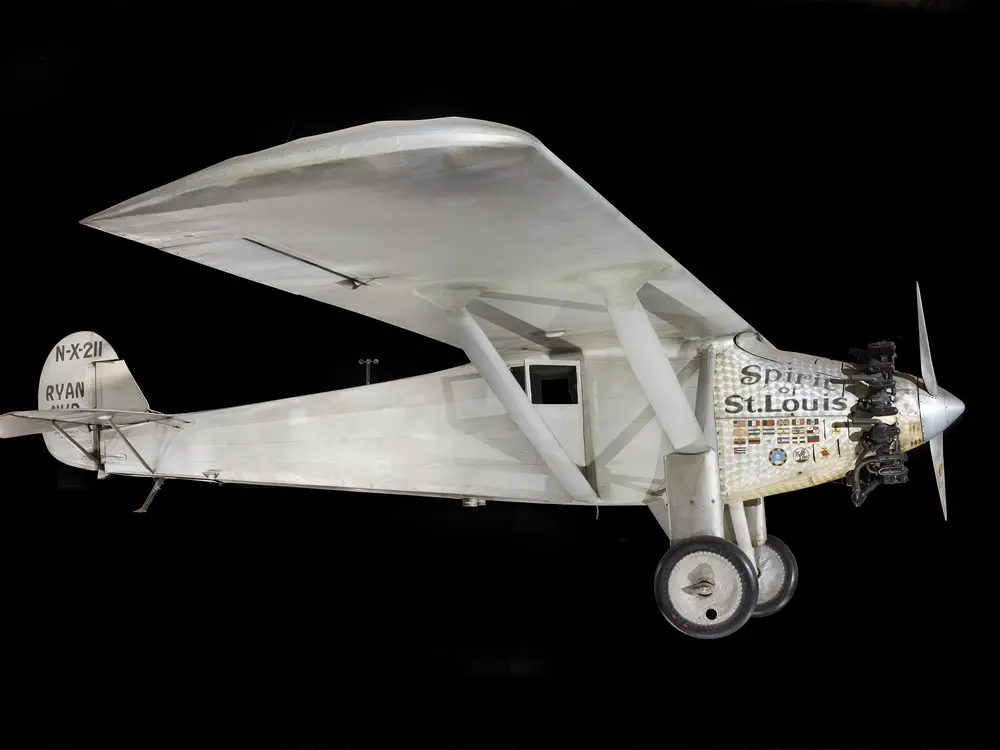
A Closer Look: The Spirit of St. Louis
Nov 08, 2016
By Thomas Paone
In May 1927, Charles Lindbergh made history when he crossed the Atlantic non-stop, solo, in this plane the Spirit of St. Louis.
The aircraft that Charles Lindbergh’s flew on his famous transatlantic flight.
The plane was built in just two months, specially modified for Lindbergh’s flight. Looking at the plane today you can see modifications that were made before the flight, in the air as Lindbergh crossed the ocean, and after Lindbergh made history when he toured the United States and Latin America with his now famous plane.
Before the Flight
A Modified Plane
The Spirit of St. Louis was built in two months based on a Ryan M-2 monoplane. However, the Spirit was customized for Lindbergh’s transatlantic flight with advanced instruments for its day. Modifications included:
- Carrying extra fuel tanks for the nonstop trip, including tanks that replaced the windscreen.
- Adding 10 feet of length to wingspan for more lift and space for more fuel tanks
- Moving the engine forward for balance and the cockpit back for safety.
- Wide landing gear was used for stability on the ground
- Ground-adjustable metal propeller for efficient cruising
- First truly reliable aircraft engine: Wright J-5C Whirlwind
No Windshield
To make space for extra fuel tanks, the Spirit didn’t have a windshield. Lindbergh peered through the periscope under the model’s wings to see straight ahead. Lindbergh used these and side windows to see where he was going.
Lindbergh was initially worried that the addition of a periscope would create excessive drag, but eventually agreed. The periscope became a critical tool during his take off and helped him avoid chimneys and tall buildings.
Messages of Luck
The spinner shroud cracked as Lindbergh flew to Curtiss Field, Long Island. Technicians replaced it before the famous transatlantic flight.
Ryan Airlines employees signed this cap and included a swastika, a good-luck symbol in many cultures. The German Nazi Party turned the swastika into a sign of hate. It’s a common misconception that the inclusion of the swastika in the plane is related to Lindbergh’s political and social beliefs—however, it is not.
Curator Bob van der Linden explains the history of the Spirit of St. Louis' spinner cap.
Evidence of Making History
Missing R
The Spirit has wooden wings and a welded steel-tube fuselage. It’s covered with cotton painted with an aluminum-colored coating called dope. The coating tightens, waterproofs, and protects the fabric from sunlight.
While fabric may seem an odd choice to us today, most aircraft prior to 1927 were covered in fabric.
After landing in Paris, spectators were eager for souvenirs of the feat, including cutting fabric from the rudder. If you look closely, you will notice the winged “R” on the left side of the rudder, and the blank patch on the right. The right side was replaced after a spectator cut it away.
Changes After the Flight
Guarded
The aircraft is covered in signatures. While the plane was on its tour of Europe, Latin America, and America in 1927 it was constantly under the watch of guards and mechanics. These “guardians” often left reminders that they were there. Signatures written in pencil or etched with a penknife can be found all over the cowling, but a number of signatures can also be found behind the propeller blade.
Dropping Flares
Look toward the bottom of the photo and you can see two black tubes in the floor of the aircraft. These tubes, under the fuselage of the aircraft, are not original to the aircraft. They were added during Lindbergh’s tour of Latin America. During late-night landings, the pilot would use the tubes to drop flares and light his landing.
Bonus Detail
Why is the Door Open?
Lindbergh gave the Spirit to the Smithsonian on April 30, 1928. The plane’s door is left open at his request.
Explore in 3D
Check out this 3D model of the Spirit of St. Louis. We are working on improving the model, but are excited to share it with you at this stage.
This blog was adapted from it’s original version, written by Thomas Paone and published with the title "Stories from Inside the Spirit of St. Louis" in 2016. In 2025, Amelia Grabowski updated the blog. You can read the original version via Internet Archive.
Related Topics
You may also like
Related Objects

We rely on the generous support of donors, sponsors, members, and other benefactors to share the history and impact of aviation and spaceflight, educate the public, and inspire future generations. With your help, we can continue to preserve and safeguard the world’s most comprehensive collection of artifacts representing the great achievements of flight and space exploration.
Support the Museum
We rely on the generous support of donors, sponsors, members, and other benefactors to share the history and impact of aviation and spaceflight, educate the public, and inspire future generations. With your help, we can continue to preserve and safeguard the world’s most comprehensive collection of artifacts representing the great achievements of flight and space exploration.








